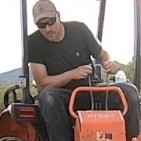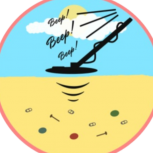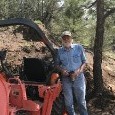-
Posts
2,501 -
Joined
-
Last visited
Profile Information
-
Gender
Not Telling
-
Location:
Wyoming
-
Interests:
supernova flotsam
-
Gear In Use:
7000 w/ X Coils, 6000, EQ800, Deus 1. Heavy equipment, XRF, fire assay furnace, range of sensors. Commercial mineral exploration.
jasong's Achievements

Platinum Contributor (6/6)
6.5k
Reputation
-

Resolved: Trying To Contact xracer550 (Alan Cook)
jasong replied to GotAU?'s topic in Detector Prospector Forum
How much was he selling those conveyors for previously? Interesting looking little devices, seem useful for getting a bunch of gravel from a hole into a truck bed instead of 5 gal buckets. -
Wondering the same. This thing came onto the online scene with a lot of promise, and it doesn't seem like I've really heard much since just in general.
-
It may be different in currencies other than USD, but the way I look at it has me a little less excited, but optimistic. Gold hit about $2000 not long after Covid hit and before inflation really kicked in full swing. $2000 in 2020, according to the Bureau of Labor's CPI inflation calculator, is worth about $2440 today, inflation adjusted. So here in the US anyways, it wasn't until the last 2 months that gold has gone above just accounting for nominal inflation on the track gold was on before inflation really went up. Price rise is nice, but at this point we seem to only just be outperforming inflation. Further increases at this rate will definitely be interesting though I think.
-
Half the story. Reality is that most exploration companies today are not US companies who are regulated by the SEC, but listed on Canadian and Australian exchanges. Then they form another LLC in some US state, in order to file mineral claims. (1872 and U.S.C. requires claimaints be US "citizens"). Being private, the SEC has no jurisdiction. Virtually every junior or explorer I've encountered has been listed on the TSX.V (Toronto). A few others in Australia. This means they don't report to the SEC other than when they fill out some forms if they sell foreign stock to US investors, or similar. Thus, the US regulatory agency responsible for ensuring they make valid discoveries on their claims is the BLM, not the SEC.
-
Yep. Exactly how it works - $ talks. It's unfortunate. I've had a BLM geologist (the one that did the permit approvals) argue with me about the whole blanket staking thing back and forth. Got nowhere, so went in and used his own "red book" to prove my point, which I was able to do. His response was basically "listen, I don't actually disagree but what you need to understand is that those large corporate project claim fees add up to big money. How much do yours add up to?" Basically - money talks and the law applies differently to me than it does to someone richer than me. I believe very strongly that laws and our rights apply to us all, regardless of how rich or poor we are though. If the law applies to me in one way, then it better apply to everyone that way to, or we have disorder and corruption.
-
A case of stats not representing reality then. In Wyoming for instance, virtually all of the historic mining districts have been blanket staked now over the past 4 or 5 years, and they extend some distance outside these areas now too. This includes uranium districts plus historic metallic districts. It's killed small scale mining and prospecting in the state and I don't know anyone who does it professionally or semi professionally who hasn't expressed some distaste at it all. For me, it's close to killing my job and business. If a company is so large that they must subvert or use shall we say "creative" interpretations of the current mining law to survive, at the expense of the small scale miners and prospectors whom that law was created for, then that's their problem, and maybe they should pursue other types of prospects instead. Or let someone else do it who can do it economically. That's the free market after all. The law is clear - a claim requires a valid discovery. And that discovery can't be any old random thing, it has to be economic by a number of measures. Further, I can't remember the exact number but something like every 5 or 10 acres of each individual claim has to be "mineral in nature" - I forget the exact verbiage. How many of these blanket stake projects would meet these definitions when they don't even put boots on the ground other than a claim staker for many of those claims? Anyways, I posted about it before, but the big thing now is uranium. And it's not going to slow down any time soon. But it getting late in the game to enter at this stage. There is a lot of money and research going into this now though, and similar topics, which I hope to eventually be able to elaborate more on.
-

Woody Has Done A Video About The Chip In The 6000 Coils
jasong replied to phrunt's topic in Detector Prospector Forum
Concentrics on the GPZ are amazing, and so are X Coils in general on the GPZ. The way your comment read, @Goldseeker5000 was as if you were referring to X Coils in general. Saying they are only for relic hunters and not for gold in that context is false. You may want to clarify that, because a lot of full time gold hunters - myself included - have shown years worth of evidence to the contrary. Anyways. Wasn't Woody talking about some new super machine he invented or was building like a year ago that was going to be coming soon? I haven't followed his channel, but why the experiments with 6000 coils if he has a better machine in the works? -
Nice, looking forward to your report. The regular 20" CC was surprisingly sensitive to what I'd consider to be smaller stuff as it was, that's pretty cool if they made it even more so. Though I suppose there is also a practical limit on just how small of stuff you want to chase with a big coil. It'd be pretty cool if it has a good measurable amount of depth (over the non-spiral) for slightly bigger stuff like ~1g though too, at least in the US there is a lot of that stuff left in the ground still at like 12+ inches.
-

GoldSeeker5000 Hits A Nice Patch Of Nuggets
jasong replied to Goldseeker5000's topic in Detector Prospector Forum
That's good you dodged the collapse, that stuff is real. I remember 20 years back when I first getting started there was a guy I met up in the Black Hills who had a boulder fall in on his leg and shatter it, and left him pinned there for the day, night, and next morning too until someone heard him yelling from the road. Good you got people up there with you. -
Yes, doing this kind of stuff is one reason I built the mapper for. Basically a front end and UI to access AI analysis on aerials, Lidar, multispectral imagery, etc. The mapping works good. The AI stuff I got on hold now though both because it's expensive to do API calls on images in bulk at the moment, but prices seem to drop regularly. Thing I'm seeing is that making AI driven apps is almost futile because the pace of improvement in the base AI models is so fast that they can just do natively by the next release whatever you have to program and build with the previous release. Might as well just wait in these cases. This stuff is for real though, I'm positive of it.
-

GoldSeeker5000 Hits A Nice Patch Of Nuggets
jasong replied to Goldseeker5000's topic in Detector Prospector Forum
Interesting, thanks. Not a lot of people leaving AZ/CA/NV today to work in the Rockies, so in a way it's kinda a frontier out here and don't really get to see what other people are doing much, so it was good to see this post. Definitely useful to have some old timer info as a starting point for some of these places if you can run across that knowledge, knowledge is all pretty much gone around here unfortunately. I will have to try the hole technique next season, fixing to snow here maybe next week. There are places that I've dug up references to oz+ nuggets, but where haven't found a single picker and not even a color in the pan, but I see some diggings on LIDAR. Seems like doing what you are doing here is about the best way to prospect those types of places. -

GoldSeeker5000 Hits A Nice Patch Of Nuggets
jasong replied to Goldseeker5000's topic in Detector Prospector Forum
Nice work! I'm curious if you could share what it is that makes you decide to outlay the work to put a hole down at the specific spots you choose? Around me all the ground up into the Rockies tends to be too deep to detect, and the forests make it so the top 1-2ft or so is all just organic duff and gold-free soil, so even doing test panning is tough and it feels like if I dug a hole it'd just be more or less blind beyond knowing the confines of some old workings. Do you just kinda find historic workings and put a hole down to bedrock to see what's there? Or do you already have some shallower findings from detecting or other testing to encourage the work at that spot or downslope first? -
USGS's MRDS database is the place to start: https://mrdata.usgs.gov/mrds/ This is a record of most of the historic mines and prospects the USGS has catalogued. It will have links to papers that reference each prospect for further reading. This page gives you options to add a WMS link in Google Earth, or download a .kmz for areas of your chosing (do the .kmz, it doesn't rely on their servers after you get the file). I made an entire video on how to do this years ago on Youtube that was called "Google Earth for Prospecting in 5 minutes" or something similar, look it up if you feel like it, I show how to get this specific layer and how to add .wms links for other data too IIRC? Unfortunately their servers are constantly running slow, if at all these days. And often crash over the weekends (like, right now it's running unusuably slow, the links barely load). I am working on creating my own map tiles and tile server to rehost some of these government layers that are just consistently working poorly or completely crashed, when I do I'll put it on Cloudflare or Amazon S3 or something that won't crash or bog down constantly like theirs does. It's been years and they just won't fix it. But if you can get to the .kmz download link, that file will work in Google Earth wether the USGS servers are down or not in the future, so snag that one and you'll always have it. That's the way to do it on your own computer - I'll update my Imagery Atlas site with it when I finish, right now I'm still learning how to convert GIS data/shapefiles to vector tiles, and then how to run my own tile server.
-
If I understand your question, then I guess yeah? But the way you phrase it makes it unclear to me if you are saying two different things here. Seems like a risky game. Does nothing to prevent someone from hanging backdated paper over your valid claim/discovery before you record it, if they catch wind of it earlier, just hobbles the paper hawks that monitor the recorder. For instance consider this example: You discover on Jan 2nd, file whenever later - say you wait the whole 90 days. Someone catches wind you are working a good discovery on Jan 30th, or sees you in the field working. Now they go record Jan 30th (yours isn't recorded yet, remember), and then they backdate their "discovery" on the loc cert to whenever - Dec 1st of the previous year. Now what? Recording or notarizing a loc cert as early as possible at least shows a court that you got something officially stamped before the claim jumper's paperwork, even if they backdate it. With the prior example, if you notarized your discovery on Jan 3rd (1 day after making the official discovery) and the claim jumper didn't record until Jan 30th, then even if they backdate the discovery fraudulently, it will be much harder for them to have any standing in court when a judge sees the paperwork IMO. Especially if you film/photo yourself doing work with timestamped photos and then submit the originals on the original phone/camera to the court, and your discovery work is the only physical work performed on the ground. Again though, not a lawyer. Not legal advice. *PS, it would be impossible to fake Youtube, Instagram/etc timestamps. So people may consider documenting a discovery this way too, or just walking the claim with a video to show no other discovery work other than your own exists, and no other location monuments, then posting to a private account which no one can see, but you can later submit as evidence if needed.
-
Mining law, both federal and state, are pretty specific in requiring an actual discovery to perfect the claim. Pursuing these issues unfortunately is often left to the prospector within the court system. Another example of how broken it all is. Re: backdating paperwork, two things: 1.) This is technically what a recorder is for - the stamp has a date and is official. However, a person can lie and say they located or discovered the prospect 30, 60, 90 (whatever) days ago. This is a bad idea, because: 2.) Lying on a recorded document is a felony violation of any number of laws I can think may apply. This not only includes people lying about the date of location, but you know all those small miner affidavits where people attest to doing at least X amount of work yearly on their claims and it's always "road work, maintenence, trash, etc" when very clearly they have not done any such things? Yeah...that's illegal too when they file it as an official document with the recorder, and it probably violates federal law too once they file it with the BLM. I'm not a lawyer though, read the law, come to your own conclusions. Recorders will say they need X, Y, and Z to look something up and often it's just the desk assistant and they are not familiar with what to do. This is why it's often best to just learn how to do everything yourself. T/R/S, document types, and date range used online, in person on recorder office computers, and the books cover 90% of it from my experience but your office may vary.


.thumb.jpg.008984156b596a0063f90b0d7fbc295b.jpg)






